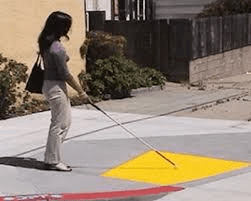

 Those who travel in wheelchairs or motorized scooters, the sight impaired who use canes, or people pushing strollers or walking a bike, depend on curb ramps to easily move between the sidewalk and the street level. The sloped ramps, generally located at intersection corners, have become commonplace throughout Seattle and the rest of the nation.
Those who travel in wheelchairs or motorized scooters, the sight impaired who use canes, or people pushing strollers or walking a bike, depend on curb ramps to easily move between the sidewalk and the street level. The sloped ramps, generally located at intersection corners, have become commonplace throughout Seattle and the rest of the nation.
All SDOT construction projects that touch intersection sidewalks require the installation of curb ramps meet ADA Accessibility Guidelines. Naturally, these standards have changed and improved since the ADA was first enacted in 1996, meaning that many of the city’s existing ramps fall short of the guidelines. For example, current standards require that curb ramps be wholly contained within a marked crosswalk and include detectible warnings so that pedestrians can easily determine the boundary between the sidewalk and the street, both intended to make them safer for their users. The required tactile warning surfaces provide a surface that is distinguishable underfoot and by cane. Also, they are generally bright yellow in color to contrast with the surrounding area, such that they provide a visual cue for low-vision pedestrians.
While many curb ramps are replaced when adjacent sidewalks and/or streets are rebuilt or resurfaced, SDOT also works to replace other substandard ramps as funding becomes available, as mandated by the federal Americans with Disabilities Act (ADA),. Each year, SDOT conducts a curb ramp inventory, prioritizing replacement on the basis of such factors as neighborhood demographics, proximity to transit connections, and the proximity to places with significant numbers of pedestrians, such as commercial districts, schools, parks, and hospitals.
The latest SDOT curb ramp replacement project (unrelated to adjacent road construction) is currently scheduled to begin construction in December, and will replace 163 curb ramps at 29 locations throughout the city. Many of these locations are at residential intersections that currently lack any curb ramps at all, while others are replacements in more commercial areas. Construction will generally have a limited impact on those living or working nearby, with work at each intersection taking two to three weeks, but with the temporary closure of some nearby on-street parking.
In addition, citizens with disabilities can request curb ramp installations at locations otherwise not scheduled for construction, which SDOT will install as funding becomes available. Under current conditions, it may take up to three years from approval to installation. To request a curb ramp, contact Brian Dougherty at 206/684-5124 or complete this online form.
Installing and maintaining curb ramps is one critical element in SDOT’s commitment to deliver a safe and reliable transportation system that serves all of Seattle’s citizens.